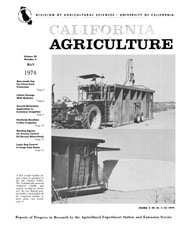All Issues

Cover:
A 24-ft module builder for seed cotton in operation in the Sun Joaquin Valley. The hydraulically-powered compacter cylinder and support carriage are shown near the rear. Raised module builder being pulled off the completed module in lower photo.
May 1974
Volume 28, Number 5
Volume 28, Number 5





